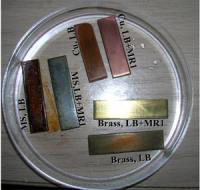Bacterium takes a shine to metals

Brass, mild steel (MS) and copper (Cu) samples compared after incubation with (+MR1) and without the presence of the bacteria. Credit: Corrosion and Environmental Effects laboratory, Mork Family Department of Materials Science and Chemical Engineering, Viterbi School of Engineering
Exposed metal surfaces are highly vulnerable to corrosion, but paint or other protective coatings can interfere with some uses, as well as add significant costs. Now, a comprehensive series of experiments suggests a new form of protection: bacteria.
Viterbi School post-doctoral researcher Ersa Kus, is the lead author on a forthcoming report on experiments by a team of materials scientists analyzing the ability of an organism called Shewanella oneidensis MR-1 (hereinafter MR-1) to protect a number of metals. The team made a preliminary presentation at a Denver conference last month, and will make a more detailed one in Mexico in October.
Scientists have long known that some bacteria can accelerate corrosion on metal surfaces, says Kus, who works in the Corrosion and Environmental Effects laboratory of Professor Florian Mansfeld of the Viterbi School's Mork Family Department of Materials Science and Chemical Engineering. A bacterium of the same genus as MR-1, S. algae, has earlier been shown to prevent pitting of aluminum and some steel.
MR-1 is a remarkable organism that can incorporate metal into its metabolism, “inhaling certain metal oxides and compounds in one form, exhaling them in another,” according to Kus's presentation. MR-1 has previously been used to precipitate uranium out of contaminated water. And “it can grow almost anywhere and does not cause disease in humans or animals,” Kus notes.
And it can protect metal.
The experiment was simple. Matched pairs of samples of four metals — aluminum 2024, zinc, mild steel, copper, and brass — were prepared. One sample set of each pair was incubated in a growth medium containing MR-1; the other in a sterile bath of the same growth medium, containing neither MR-1 nor any other organism.
After a week, corrosion was monitored, both visually and by measuring electrochemical impedance (resistance to conducting alternating current.) Because electrical effects play a role in many forms of corrosion, higher AC impedance is associated with increased corrosion resistance.
The results were clearcut. For all the materials, impedance increased with exposure to bacteria, and the longer the metals were exposed, the more resistant they became. The increase was particularly marked in the aluminum samples. By the end of the week the control samples showed obvious visual pitting, while the ones with MR-1 colonies were unscathed.
The pattern of impedance varied from metal to metal. Aluminum showed drastic reduction in resistance to electrical currents in all frequencies. Brass and, particularly copper showed nearly as dramatic an effect — readings indicated active corrosion in the control samples, but a large reduction in the MR-1 samples. The copper MR1 samples, in fact, showed a profile similar to that demonstrated by copper covered with a protective polymer plastic film.
The patterns for steel and zinc were much less marked, but still significant, as was the difference in the metals' appearance.
The next step, according to Kus, is to figure out exactly what is going on and determine where and how the presence of bacteria is altering the corrosion equation. To do this, the group will be making molecular scale analysis of bacteria/metal interfaces, and looking to determine what the properties of MR1 biofilm are, as well as why the pattern of interaction differs from metal to metal.
While MR1 itself may not be the metal protector of the future, it may well suggest an agent that can be, Kus says. The research will be presented at the 210th Meeting of The Electrochemical Society in Cancun, Mexico, October 29-November 3, 2006
Media Contact
More Information:
http://www.usc.eduAll latest news from the category: Materials Sciences
Materials management deals with the research, development, manufacturing and processing of raw and industrial materials. Key aspects here are biological and medical issues, which play an increasingly important role in this field.
innovations-report offers in-depth articles related to the development and application of materials and the structure and properties of new materials.
Newest articles

Durable, Efficient, Sustainable: The Rise of Cerium Oxide Thermal Switches
Groundbreaking cerium oxide-based thermal switches achieve remarkable performance, transforming heat flow control with sustainable and efficient technology. Cerium Oxide-Based Thermal Switches Revolutionize Heat Flow Control Thermal switches, which electrically control…

How Industrial Robots are Reducing Emissions in Global Manufacturing
A new study explores the intersection of industrial automation and environmental sustainability, focusing on the role of industrial robots in reducing the carbon intensity of manufacturing exports. The research demonstrates…

Patients Can Heal Through Precise, Personalized Bioceramic Grafts
A recent review is transforming the landscape of craniomaxillofacial bone regeneration with the introduction of personalized bioceramic grafts. This pioneering research explores the fabrication and clinical potential of synthetic grafts…



